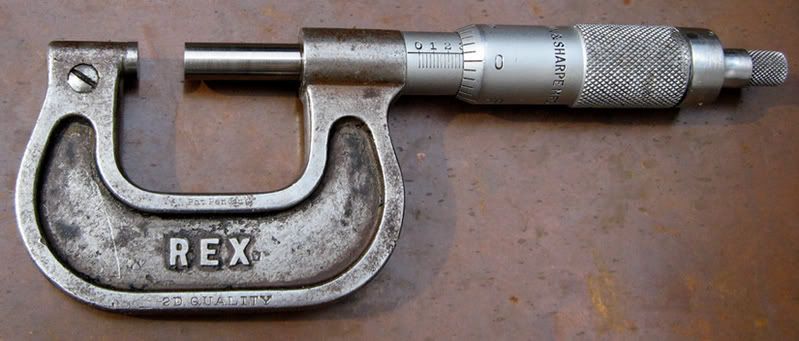Mic addict
Cast Iron
- Joined
- Mar 13, 2006
Here's an ugly looking (really) but interesting mic.
Back in the 20's n 30's B&S had a less expensive line of tools called 'Rex'.
This one was from early on in the production run as it has the adjustable anvil and the frame was only painted black in the recess, not the entire frame as was done from the mid 20's onward. At some point in its life the thimble with its narrow band of knurling at the end and decimal equivelants table was replaced with the adjustable type thimble. At that point or after it had the barrel and thimble hard chromed. Then someone replaced the end cap with a plain finish one. Later still someone used a pair of pliers to get it off leaving big gouges in the knurling and cap itself. I smoothed the cap with emery paper a bit but otherwise will leave it as is.
The frame is stamped '2d quality' and 'pat pending' which is why I figure the ribs of the
frame were not painted black. Not very collectable but its fun to look at and imagine all that its seen. Besides ugly beaten tools need love too.

Back in the 20's n 30's B&S had a less expensive line of tools called 'Rex'.
This one was from early on in the production run as it has the adjustable anvil and the frame was only painted black in the recess, not the entire frame as was done from the mid 20's onward. At some point in its life the thimble with its narrow band of knurling at the end and decimal equivelants table was replaced with the adjustable type thimble. At that point or after it had the barrel and thimble hard chromed. Then someone replaced the end cap with a plain finish one. Later still someone used a pair of pliers to get it off leaving big gouges in the knurling and cap itself. I smoothed the cap with emery paper a bit but otherwise will leave it as is.
The frame is stamped '2d quality' and 'pat pending' which is why I figure the ribs of the
frame were not painted black. Not very collectable but its fun to look at and imagine all that its seen. Besides ugly beaten tools need love too.



